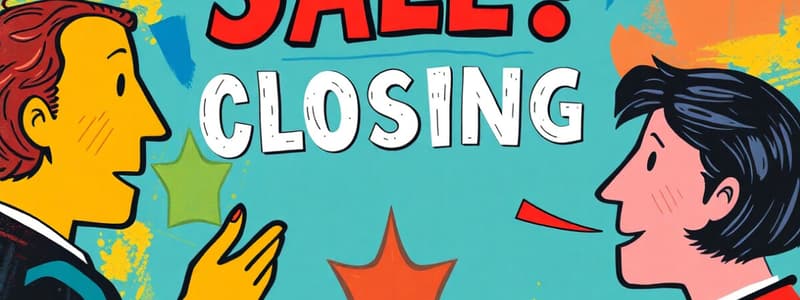Podcast
Questions and Answers
What often causes salesmen to lose sales?
What often causes salesmen to lose sales?
- Moving too slowly without building rapport
- Offering discounts too early in the conversation
- Focusing on a single customer rather than multiple leads
- Not clearly defining their own wants before selling (correct)
When should a salesman be ready to close a sale?
When should a salesman be ready to close a sale?
- After establishing a price point the customer is comfortable with
- Once they have a clear understanding of both their own wants and the customer's needs (correct)
- Before determining the customer's level of interest
- After offering the customer multiple products to choose from
How does the salesman perceive the customer when they close the door?
How does the salesman perceive the customer when they close the door?
- As a patient who is hesitant about their decision
- As a prospect that needs convincing through discounts
- As a competitor whose choice must be swayed
- As someone who is ready and willing to buy (correct)
What does the salesman assume when discussing the color of a product?
What does the salesman assume when discussing the color of a product?
What strategy is suggested when a customer seems hesitant?
What strategy is suggested when a customer seems hesitant?
What is the purpose of asking for a deposit when selling a car?
What is the purpose of asking for a deposit when selling a car?
How does the salesperson approach potential objections from the customer when discussing payment?
How does the salesperson approach potential objections from the customer when discussing payment?
What strategy does the salesperson use to ensure customers perceive value in the car purchase?
What strategy does the salesperson use to ensure customers perceive value in the car purchase?
What psychological tactic does the salesperson employ by asking for a specific deposit amount?
What psychological tactic does the salesperson employ by asking for a specific deposit amount?
Why does the salesperson prefer checks over cash for deposits?
Why does the salesperson prefer checks over cash for deposits?
What fundamental assumption does the salesperson make about the customer when they hand over a check?
What fundamental assumption does the salesperson make about the customer when they hand over a check?
In terms of competition, what does the salesperson believe gives them an advantage in selling cars?
In terms of competition, what does the salesperson believe gives them an advantage in selling cars?
What is the main advantage of spot delivering the car to the customer?
What is the main advantage of spot delivering the car to the customer?
What does the author believe is the least important factor when a customer decides to buy a new car?
What does the author believe is the least important factor when a customer decides to buy a new car?
Which strategy is employed to prevent the customer from looking elsewhere?
Which strategy is employed to prevent the customer from looking elsewhere?
How does the author react to a customer’s hesitation regarding payment?
How does the author react to a customer’s hesitation regarding payment?
What is a potential risk of special ordering a car for the customer?
What is a potential risk of special ordering a car for the customer?
What does the author suggest about colors available for cars?
What does the author suggest about colors available for cars?
Which of the following is NOT mentioned as a reason for customers to back out of a car order?
Which of the following is NOT mentioned as a reason for customers to back out of a car order?
Why does the author emphasize the importance of having cars in stock?
Why does the author emphasize the importance of having cars in stock?
What is the author’s approach when a customer's desired car is not available?
What is the author’s approach when a customer's desired car is not available?
What primary factor is emphasized as crucial for maintaining a sale after the initial transaction?
What primary factor is emphasized as crucial for maintaining a sale after the initial transaction?
What strategy does Joe Girard use to prevent customers from looking at competitor prices?
What strategy does Joe Girard use to prevent customers from looking at competitor prices?
Why does Joe Girard believe he should not sell cars too cheaply?
Why does Joe Girard believe he should not sell cars too cheaply?
What risk does Joe Girard associate with accepting only a small deposit from customers?
What risk does Joe Girard associate with accepting only a small deposit from customers?
What does Joe Girard believe customers underestimate in the car buying process?
What does Joe Girard believe customers underestimate in the car buying process?
How does Joe Girard view the need for customers to brag about purchase prices?
How does Joe Girard view the need for customers to brag about purchase prices?
What does Joe Girard mean by saying ‘trusting me after the sale is what counts’?
What does Joe Girard mean by saying ‘trusting me after the sale is what counts’?
What does spot delivery imply about customer ownership perception?
What does spot delivery imply about customer ownership perception?
When does Joe Girard feel a customer is truly sold on a deal?
When does Joe Girard feel a customer is truly sold on a deal?
Flashcards
Sticking point
Sticking point
The point in the sales process where a customer hesitates or shows resistance, making it more challenging to close the deal.
Define your own want
Define your own want
In sales, this means clearly identifying your own personal goals and motivations for making the sale, even if it's just pushing yourself to outperform your previous results or compete with other salespeople.
Moving the customer along
Moving the customer along
A sales approach that acknowledges the customer's potential desire to buy but assumes they need guidance and reassurance throughout the process.
Assuming the customer wants to buy
Assuming the customer wants to buy
Signup and view all the flashcards
Closing the Sale
Closing the Sale
Signup and view all the flashcards
Asking for money early
Asking for money early
Signup and view all the flashcards
Hammering a check
Hammering a check
Signup and view all the flashcards
Price flexibility
Price flexibility
Signup and view all the flashcards
Building trust and fairness
Building trust and fairness
Signup and view all the flashcards
Creating an unbeatable deal
Creating an unbeatable deal
Signup and view all the flashcards
Understanding customer needs
Understanding customer needs
Signup and view all the flashcards
Building Trust through Low Prices
Building Trust through Low Prices
Signup and view all the flashcards
Trust Beyond the Sale
Trust Beyond the Sale
Signup and view all the flashcards
Capitalizing on the Brag Factor
Capitalizing on the Brag Factor
Signup and view all the flashcards
Building a Relationship for Future Sales
Building a Relationship for Future Sales
Signup and view all the flashcards
The Power of the Deposit
The Power of the Deposit
Signup and view all the flashcards
Securing a Big Deposit Before Financing
Securing a Big Deposit Before Financing
Signup and view all the flashcards
Spot Delivery
Spot Delivery
Signup and view all the flashcards
The Perception of Ownership
The Perception of Ownership
Signup and view all the flashcards
The Driving Advantage
The Driving Advantage
Signup and view all the flashcards
Selling the Available Car
Selling the Available Car
Signup and view all the flashcards
The Color Factor
The Color Factor
Signup and view all the flashcards
Instant Gratification
Instant Gratification
Signup and view all the flashcards
Building Trust
Building Trust
Signup and view all the flashcards
Addressing Customer Concerns
Addressing Customer Concerns
Signup and view all the flashcards
Urgency and Risk
Urgency and Risk
Signup and view all the flashcards
Study Notes
Sales Techniques
- Moving Past Hesitation: Salespeople often lose sales by pushing too hard too soon. Instead, focus on understanding the customer's needs before closing. Imagine the customer's face as a bag of groceries to motivate personal drive and commitment to the sale.
Identifying Customer Wants
- Defining Salesperson's Want: Knowing what you want (e.g., surpassing yesterday's sales, beating competitor's records, reaching top sales) motivates selling efforts and helps in every sales interaction. This knowledge is crucial for understanding customers and their potential wants.
The Closing Process - Key Steps
-
Intelligence Gathering: Before closing a sale, thoroughly understand both what the customer wants and what you want out of the deal. This is akin to a surgeon's assessment before operating on a patient.
-
Color as a Cues: Asking about a car's color is a strong indicator of a customer's readiness to buy. If a customer mentions a color it often indicates the purchase is past the point of no return.
-
Proactive Closing: Rather than passively asking for a deposit or order, ask for a smaller amount (e.g., $100) and be prepared to adjust based on the customer's response. This more assertive approach avoids putting the customer on the defensive.
-
Handling Partial Deposits: Be flexible with deposit amounts. If a customer only has a fraction of the amount, accept it, but ensure they leave ample money in case of financing problems or unexpected changes.
Spot Delivery
-
Risky but Effective: Offering spot delivery (giving the customer the car even if the final paperwork isn't complete) to create a sense of ownership and disincentivize further shoping.
-
Creating a sense of obligation: The customer's possession of the car creates a moral obligation to make the deal happen. A signed documentation outlines their responsibility to return the vehicle if the deal does not go through.
-
Insurance and Spot Delivery: Use similar strategies in other industries; for example, an insurance agent giving coverage with a temporary binder allows customers to see and appreciate insurance benefits immediately while details are finalized.
-
Understanding Customer's Priorities: The author emphasizes the importance of assessing customer needs instead of focusing on extra optional elements. The actual car (its make, style, and features) and its cost are primary factors that drive potential buyers. Color is often a secondary concern in comparison to price.
Price Negotiations and Sales Strategies
-
Competition and Fairness: Acknowledge direct competition and the importance of offering fair prices and deals, avoiding unethical tactics. It is not uncommon to lose some sales but maintaining customer trust and positive feedback can increase overall sales.
-
Flexibility in Pricing: Be prepared to adjust prices by offering lower pricing in consideration to comparable options (either lower car costs or less commission). Focus, in part, on the significant difference in options and features, so a negotiation regarding features may reduce the overall price.
-
Price Comparison Clarity: Be transparent about price comparisons to avoid confusion and maintain trust. Explain to the customer the reasons behind pricing discrepancies.
-
Customer Trust Enhancement: Establish trust and rapport through clear communication about the actual sale and price. Providing clear pricing on the monthly payments and total costs of the car are key elements to maintaining customer trust.
Final Considerations
- Avoid Unnecessary Pressure: Do not force a sale. Give customers the leeway and respect to choose.
- Trust and Integrity: Maintaining trust and honest dealings are essential to long-term sales success; a reputable dealer earns repeat business and positive testimonials.
Studying That Suits You
Use AI to generate personalized quizzes and flashcards to suit your learning preferences.


